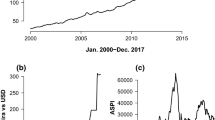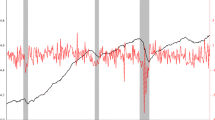Abstract
This study investigates the impact of surprises in hourly wages, non-farm payroll, unemployment rate, and producer price index on the yields and volatilities of money market securities. The methodology is conducted in a framework that preserves the strong substitutability among the instruments. We find first the short-term interest rate nexus is inherently a steady state long-run phenomenon. Second, yield variability is fundamentally linked to the release of macroeconomic news that conveys important information on inflation. Third, results from the equality of variance tests suggest that volatilities on announcement days are significantly higher than non-announcement day volatilities across all securities.
Similar content being viewed by others
References
Akaike, H. 1973. “Information Theory and an Extension of the Maximum Likelihood Principle.” In2nd International Symposium on Information Theory, edited by B. N. Petrov and F. Craki. Budapest: Akademiai Kiado.
Balduzzi, P., E. J. Elton, and T. C. Green. 2001. “Economic news and Bond Prices: Evidence from the U.S. Treasury Market.”Journal of Financial and Quantitative Analysis.
Becker, G., Finnerty, J., and K. Kopecky. 1995. “Domestic Macroeconomic News and Foreign Interest Rates.”Journal of International Money and Finance 14: 763–783.
Berkman, N. G. 1978. “On the Significance of Weekly Changes in M1.”New England Economic Review: 5–22.
Bradley, M. G., and S. A. Lumpkin. 1992. “The Treasury Yield Curve as a Cointegrated System.”Journal of Financial and Quantitative Analysis 27: 449–463.
Brown, M., and A. Forsythe. 1974. “Robust Tests for the Equality of Variances.”Journal of the American Statistical Association 69: 364–367.
Brunner, K., and A. H. Meltzer. 1990. “Money Supply.” InHandbook of Monetary Economics, Vol. 1., edited by B. M. Friedman and F. H. Hahn, North-Holland, Amsterdam, pp. 357–396.
Campbell, J. Y., and R. J. Shiller. 1987. “Cointegration and Tests of Present Value Models.”Journal of Political Economy 95: 1062–1088.
Cheng, B. S., and T. W. Lai. 1997. “Government Expenditures and Economic Growth in South Korea: A VAR Approach.”Journal of Economic Development 22: 11–24.
Christie-David, R., and T. W. Koch. 1997. “The Impact of Market-Specific Public Information on Return Variance in an Illiquid Market.”The Journal of Futures Markets 17: 887–908.
Christie-David, R., and M. Chaudhry. 1999. “Liquidity and Maturity Effects around News Releases.”Journal of Financial Research 22: 47–67.
Christie-David, R., and M. Chaudhry, 2000. “January Anomalies: Implications for the Market's Incorporation of News.”The Financial Review 35: 79–96.
Conover, W., and M. Johnson, 1981. “A Comparative Study of Tests for Homogeneity of Variances, with Applications to the Outer Continental Shelf Bidding Data.”Technometrics 23: 351–361.
Cutler, D. M., J. M. Poterba, and L. H. Summers. 1989. “What Moves Stock Prices?”Journal of Portfolio Management 15: 4–12.
Cornell, B., 1982. “Money Supply Announcements, Interest Rates, and Foreign Exchange.”Journal of International Money and Finance 1: 201–208.
Cornell, B. 1983. “The Money Supply Announcements Puzzle: Review and Interpretation.”American Economic Review 73: 644–657.
Dickey, D. A., and W. A. Fuller. 1981. “Likelihood Ratio Statistics for Autoregressive Time Series.”Econometrica 49: 1057–1072.
Ederington, L. H., and J. H. Lee. 1993. “How Markets Process Information: News Releases and Volatility,”Journal of Finance 48: 1161–1191.
Elder, J., and P. Kennedy. 2001. “Testing for Unit Roots: What Should Students Be Taught?”Journal of Economic Education 32: 137–146.
Evans, Martin, and K. Lewis. 1995. “Do Expected Shifts in Inflation Affect Estimates of the Long-Run Fisher Relation?.”Journal of Finance 50: 225–253.
Fleming, M. J., and E. Remolona. 1997. “What Moves the Bond Market?” Federal Reserve Bank of New York,Economic Policy Review 3: 31–50.
Gonzala, J. 1994. “Comparison of Five Alternative Methods of Estimating Long Run Equilibrium Relationship.”Journal of Econometrics 60: 203–233.
Griffiths, W., and G. Judge. 1992. “Testing and Estimating Location Vectors When the Error Covariance Matrix is Unknown.”Journal of Econometrics 54: 121–138.
Grossman, J. 1981. “The ‘Rationality’ of Money Supply Expectations and the Short-Run Response of Interest Rates to Monetary Surprises.”Journal of Money, Credit and Banking 13: 409–424.
Hall, A. D., H. M. Anderson, and C. W. J. Granger. 1992. “A Cointegration Analysis of Treasury Bill Yields.”Review of Economics and Statistics 74: 117–126.
Hardouvelis, G. 1987. “Macroeconomic Information and Stock Prices.”Journal of Economics and Business 39: 131–140.
Johansen, S. 1991. “Estimation and Hypothesis Testing for Cointegration Vectors in Gaussian Vector Autoregressive Models.”Econometrica 59: 1551–1580.
Johansen, S., and K. Juselius. 1990. “Maximum Likelihood Estimation and Inference on Cointegration: With Applications to the Demand for Money.”Oxford Bulletin of Economics and Statistics 52: 169–210.
Jones, C. M., O. Lamont, and R. L. Lumsdaine 1998. “Macroeconomic News and Bond Market Volatility.”Journal of Financial Economics 47: 315–337.
Kandel, S., A. Ofer, and O. Sarig. 1995. “Real Interest Rates and Inflation: An Ex Ante Empirical Analysis.” Working paper, University of Pennsylvania.
Levene, H. 1960. “Robust Tests for the Equality of Variances.” InContributions to Probability and Statistics, edited by I. Oldkin. Standford University Press, Palo Alto, CA, 278–292.
Li, L., and R. F. Engle. 1998. “Macroeconomic Announcements and Volatility of Treasury Futures.” Discussion Paper 98-27, Department of Economics, University of California. San Diego.
Lockwood, L. J., and S. C. Linn. 1990. “An Examination of Stock Market Return Volatility During Overnight and Intraday Peroids, 1964–1989.”Journal of Finance 45: 591–601.
MacKinnon, J. G. 1991. “Critical Values for Cointegration Tests” InLong-Run Economic Relationships: Readings in Cointegration, edited by R. F. Engle and C. W. J. Granger, Oxford University Press.
McQueen, G., and V. V. Roley. 1993. “Stock Prices, News, and Business Conditions.”Review of Financial Studies 6: 683–707.
Mishkin, F. 1992. “Is the Fisher Effect for Real? A Reexamination of the Relationship between Inflation and Interest Rates.”Journal of Monetary Economics 30: 195–215.
Mougoue, M. 1992. “The Term Structure of Interest Rates as a Cointegrated System: Empirical Evidence from the Eurocurrency Market.”Journal of Financial Research 15: 285–296.
Pearce, D. K., and V. V. Roley. 1985. “Stock Prices and Economic News.”Journal of Business 58: 49–67.
Phillips, P. 1991. “Optimal Inference in Cointegrated Systems.”Econometrica 59: 283–306.
Phillips, P., and P. Perron. 1988. “Testing for a Unit Root in Time Series Regression.”Biometrica 75: 335–346.
Roley, V. V. 1983. “The Response of Short-Term Interest Rates to Weekly Money Announcements.”Journal of Money, Credit and Banking 15: 344–354.
Schwert, W. G. 1981. “The Adjustment of Stock Prices to Information about Inflations.”Journal of Finance 36: 15–29.
Shea, G. S. 1992. “Benchmarking the Expectations Hypothesis of the Interest-Rate Term Structure: An Analysis of Cointegration Vectors.”Journal of Business and Economic Statistics 10: 347–666.
Urich, T., and P. Wachtel. 1981. “Market Response to the Weekly Money Supply Announcements in the 1970s.”Journal of Finance 36: 1063–1072.
Wallace, M., and J. Warner. 1993. “The Fisher Effect and the Term Structure of Interest Rates: Tests of Cointegration.”Review of Economics and Statistics 75: 320–324.
Author information
Authors and Affiliations
Rights and permissions
About this article
Cite this article
Ramchander, S., Simpson, M.W. & Chaudhry, M. The impact of inflationary news on money market yields and volatilities. J Econ Finan 27, 85–101 (2003). https://doi.org/10.1007/BF02751592
Issue Date:
DOI: https://doi.org/10.1007/BF02751592




